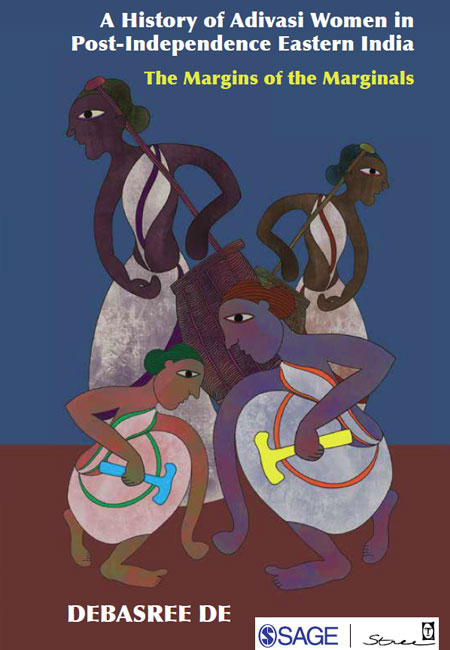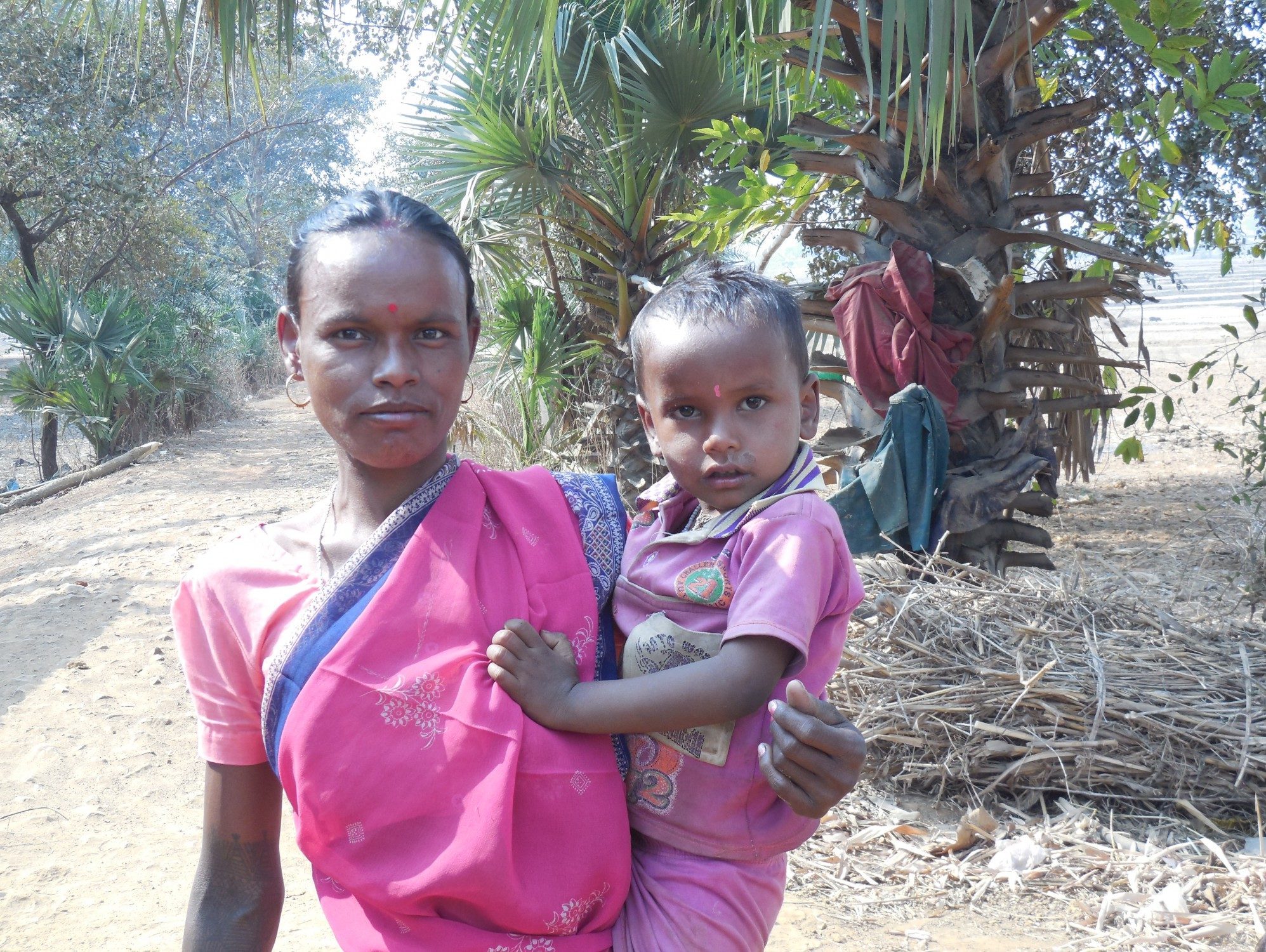‘Bhanmati had on a short plum coloured sari that she wore above her knees, a green and red necklace of hinglaj, and she had a spider lily tucked into her hair. She looked more healthy and comely than when we had last met – her slender body brimmed over with a sweet youthfulness, though the expression in her eyes spoke of the same innocent girl I knew.’
This mesmerising description of Bibhutibhushan’s Bhanmati creates a perfect picture of a tribal woman.[i]
But this portrayal of Bhanmati gives us a partial notion about a tribal woman. This is no doubt one among the many shades of her life. The rests are unspoken and extremely under-researched.
***
Seventy years after independence and about the same span of planned development, women’s position in India is still grim. Their position has worsened considerably in almost every sphere of life with the exception of some gains for middle-class women in terms of education and employment. The available literature on women in India has brought to light many negative social practices like rape, wife-battering, domestic violence, dowry deaths, prostitution, and working long hours within and outside the home without recognition. All this indicates that women are still perishing at the periphery of the mainstream (read mail stream) society.
This study focuses on the nature and dimensions of changes in the life and status of tribal women, rural and urban, in eastern India. It deals with the changing livelihood pattern of the adivasi women in four states: West Bengal, Bihar, Jharkhand and Odisha of eastern India. Gender issues are manifested differently in different locations and hence one should not ignore the sociology of space while discussing such issues. The impact of modern forces and institutions on tribal women are more conspicuous in the urban spaces relative to the rural areas. These changes have exacerbated some new gender and class issues unprecedented in the purportedly egalitarian society of the tribals. Within this context, the struggles of Indian tribal women against class and gender inequality acquire particular significance. The notion of ‘indigenous’ is especially germane here, for tribals are considered India’s earliest inhabitants. Moreover, tribal women’s resistance has generally occurred quite autonomously from urban feminist movements.
Previously, gender studies was regarded as an addendum and women’s movements as a concomitant movement. It is the indigenous women are leading grassroot democracy. Women have always been doubly colonized. Their stories have always remained at the periphery. Realization of this is evident in the establishment attached to various universities in India. An objective and scientific interpretation of culture from the women’s point of view is, however, still lacking. Women scholars have not yet been able to carve out a niche for themselves where their position is secure. There is still a voice in the wilderness; a voice seldom heard even by women themselves. And it is not surprising that not a single woman scholar has ever tried to deal with the status of tribal women. What Begum Rokeya Sakhawat Hossain did on Muslim women, M. Borthswick did on Bengali upper caste bhadramahila and Devaki Jain on working class women; we do not find that extensive research on tribal women by any woman historian. Among those who are striving hard to represent women are anthropologists. As Mahale has rightly stated:
By providing a new perspective for women’s studies, anthropologists have encouraged a good deal of re-examination of existing theories, critical questioning and research and have contributed towards extending the frontiers of Anthropology. [ii]
But women and anthropologists have a long way to go, and this is even truer for tribal women. Thus it automatically creates the vacuum. There are a large number of studies on tribal communities but only a few are focused on tribal women. There is hardly any substantial work undertaken in order to understand the concept of tribal women. Interests seem to revolve around the social status of tribal women and not on conceptual clarifications and on the problems they are facing today. Reviewing the studies of tribal women, K.S. Singh has concluded that there is ‘need for generating studies which can fill the information gap about variations that exist and about the role and status of tribal women from one region to another and one community to another’. [iii] Singh has also reiterated that there are materials on tribals in general but the existing literature specifically on tribal women is limited. [iv] Health statistics also give an overall picture and data on gender differentiation of longevity, level of health, extent of mortality, infant mortality, nutrition are not available. There is a dearth of base-line data on certain basic parameters relating to tribal women, their status, that data on various tribes at least are needed as they differ from one another. [v] Generally speaking the parameters used to define tribal women; their roles and status are different from those used for men. This is unfortunate. They are, for instance, depicted as the preservers of culture and social life whereas men are glorified as hunters and killers. The general tendency to define men in tribal society in terms of role categories like warriors, hunters, statesman and elder has little to do with their relationship with women. Women by contrast tend to be defined almost entirely in relational terms, in terms of kin roles as, wife, mother, sister. In other words, while men can be defined independent of women, the latter cannot be defined independent of men.
I see tribal woman as a category or as an interest group which is considered as a ‘labour force’, a ‘victim’, a ‘protester’ by the policy makers and planners or is increasingly being looked down upon as a ‘witch’ or as a mere ‘sexual object’ by the tribal and non-tribal men respectively. The work studies, the production of tribal women as invisible and oppressed, ‘backward’ in the written history of India. My focus is on understanding the discursive and material contexts that have historically produced tribal women as victimized, invisible and mute. The specific disappearance of the tribal women in Bengali literature and the ways in which they have been marginalized and made to disappear within both the conventional (colonial and nationalist) and critical historiography of India is a matter of concern. As entrenched realities of adivasi women’s life – lived and thought – the problematic of gender and ethnicity have constantly questioned my bourgeois/educated standpoint. I have always tried to be a part of their journey of identity, making, unmaking and remaking it through gendered lenses.
Tribal women of eastern India are not a homogeneous group, although they are known by the generic category ‘tribal women’. They are a socially excluded category which has not appeared suddenly but is created through a historical process. It is true that there are a lot of differences and discrepancies among the different tribal groups. These are essentially cultural differences. We find varieties of culture in tribal communities of India. It is important to remember that ‘tribal women’ are also diverse ethnically, linguistically, geographically and also historically. The social factors sometimes contradict as well because the nature of patriarchy differs from one tribe to another. The main cultural areas where different tribal groups differ are – language, script, festivals, customs, folk traditions (songs, lore, tales, proverbs, and so on), art and crafts, ornaments, dress, marriage ceremonies, sexual behaviour, social taboos and the like. But does culture mean only these things? I think culture denotes a way of life. These are, in fact, the colourful side of the tribal life, but there is also a dark side as the women in tribal societies are often considered doubly disadvantaged, in the first instance as tribal and in the second, as a woman. The discrimination, humiliation, torture, harassment that a caste woman faces, is also faced by her. If she is beaten by her drunk husband she feels pain, if she the whole day she gets tired, if she gets displaced she laments for her hut, if she loses her job in the course of deforestation for mining she starves, if she gets raped her entire personality shatters. She takes up arms to save the forests (in the Chipko movement by Bhutia women), the hills (movement against Vedanta by Dongria Kondh women of Niyamgiri hills), the lands (Bhil women in Dhulia land struggle of Maharashtra, movement in Kalinganagar against TISCO), the rivers (Dongria Kondh women against damming the Indravati River, Odisha, tribal women are also active in the Narmada Bachao Andolan, Gujarat, Madhya Pradesh and Maharashtra), the dignity and the future of her children that have been destroyed by the gargantuan consumptive greed of the global market.
According to Bina Agarwal,
Tribal women are the second major category facing substantial disabilities in inheritance. Given the non-codification of their laws, tribal communities are governed by customs which (except under matriliny) discriminate against women. And even the limited customary land rights many tribal women enjoyed historically have been eroding. [vi]
So, we should attempt to link land resource rights for tribal women as the central point of all the gender inequity making its entry in the tribal community, and we should not forget patriarchy can take various shapes and forms: from globalization ‘thrusted’ to feminization of poverty to violence against women in the name of customs. Simon de Beauvoir has suggested in The Second Sex that ‘one is not born a woman, but, rather, becomes one’. [vii]
For de Beauvoir, women are designated as the Other, women are the negative of men, the lack against which masculine identity differentiates itself. There are hundreds of attempts being tried to create a better world for tribal women: from the tribal identity protection perspective, from women’s right perspective, from the perspective of community control over natural resources, from labour rights perspective in this globalized economy. But still there is concern for a society based on justice and this includes gender justice issues in tribal community.

[i] Bibhutibhusan Bandyopadhyaya, Aranyak – Of the Forest: 181.
[ii] P. Mahale, 1991. ‘Towards an Anthropology of Women’, in Relevance of Anthropology: The Indian Scenario, edited by B.G. Halbar and C.G. Hussain Khan (Jaipur: Rawat): 103.
[iii] K, S. Singh, ‘Tribal women: Anthropological Perspective’, in Singh, Vyas and Mann, eds, Tribal Women and Development .
[iv] K. S. Singh, ‘Tribal Perspectives – 1969-1990’, in Miri, ed., Continuity and Change in Tribal Society:5-10;, and also see Singh, 1993. ‘Status of Scheduled Tribes Some Reflections on the Debate on the Indigenous Peoples’, Social Change 23, 2&3.
[v] B. Singh, 1993. ‘An Outline of Work to Be Taken Up on Tribal Women’, Working Papers: NCW.
[vi] Bina Agarwal, 2005, ‘Women’s Inheritance: Next Steps: A Look at the Disabilities Non-Hindu Women Face’; column, The Indian Express, Monday, Oct 17.
[vii] De Beauvoir, The Second Sex: 301.
Excerpted with permission from A History of Adivasi Women in Post-Independence Eastern India: The Margins of Marginals, Sage-Stree;
Pages: 450
Price: Rs 995

